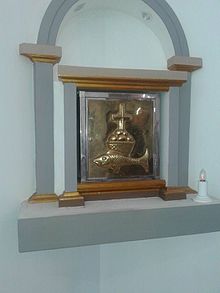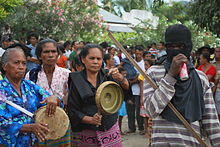Roman Catholic Church in East Timor

The majority of the population in East Timor is committed to the Roman Catholic Church .
situation
| Christians in East Timor (2010) | |||||
| local community | population | Catholics | Protestants | ||
| Ainaro | 58,147 | 57,221 | 98.4% | 677 | 1.2% |
| Aileu | 46,664 | 39,919 | 85.5% | 3,168 | 6.8% |
| Baucau | 110.160 | 107.998 | 98.0% | 1,729 | 1.6% |
| Bobonaro | 911.199 | 90,815 | 99.6% | 200 | 0.2% |
| Cova Lima | 59,045 | 58,874 | 99.7. % | 96 | 0.2% |
| Dili | 228,559 | 216.047 | 94.5% | 8,858 | 3.9% |
| Ermera | 116,937 | 114,927 | 98.3% | 823 | 0.7% |
| Liquiçá | 63.171 | 60.193 | 95.3% | 1,694 | 2.7% |
| Lautém | 59,776 | 87,784 | 96.7% | 1.611 | 2.7% |
| Manufahi | 48,614 | 46,674 | 96.0% | 1,782 | 3.7% |
| Manatuto | 41,709 | 40,966 | 98.2% | 375 | 0.9% |
| Oe-Cusse Ambeno | 63,514 | 63,065 | 99.3% | 381 | 0.6% |
| Viqueque | 69,476 | 66,764 | 96.1% | 2,314 | 3.3% |
| East Timor | 1,063,971 | 1,021,247 | 96.0% | 23,708 | 2.2% |
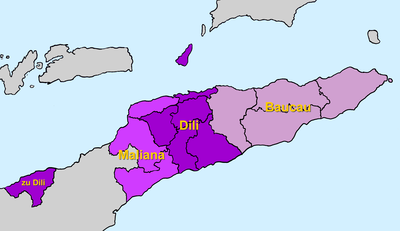
|
|||||




East Timor is a secular state and there is freedom of religion according to the constitution . In his inaugural address as Prime Minister in 2006 , however, José Ramos-Horta emphasized the importance of the Catholic Church as an element that unites the country and reconciles the various conflicting parties. On August 14, 2015, a concordat was signed between East Timor and the Vatican on the occasion of the 500th anniversary of the evangelization of Timor . It defines the areas in which the Catholic Church can act independently of the state, for example in the case of spiritual care in prisons, hospitals and orphanages and in running its own schools at every level of education. There has been an Apostolic Nuncio in East Timor since 2003 . In 2007 the first ambassador of East Timor was sent to the Holy See .
96% of the East Timorese are Catholic , only 2.2% belong to a Protestant faith (2010). Despite this dominance of Christianity, many rites and beliefs of the original animistic religion of Timor are still common in everyday life . They are often integrated into the Christian faith. During the freedom struggle against Indonesia , the Catholic Church became the unifying bracket between the tribal associations against the predominantly Muslim Indonesians. By 2002 the proportion of Catholics in the population increased to over 90 percent. Liberation theology from Latin America had a strong influence . Another reason for the increase in Catholics was that the inhabitants of East Timor had to choose between one of the five recognized religions (Islam, Catholic and Protestant Christianity, Hinduism, Buddhism) when registering with the Indonesian authorities. Under the pressure of the election, most East Timorese opted for Catholicism. It is sometimes assumed that similarities between the old, animistic religion and the Catholic faith, such as the veneration of the dead and icon worship, played a role here. The Mambai have a legend of Mau Terus , the suffering man who is murdered but then rises again. Parallels to Jesus Christ are drawn here. Wehale , the ancient spiritual center of Timor, is considered female in Timorese mythology, which leads to an association with Mary, the Mother of God.
A number of movements , such as Colimau 2000 or the Sagrada Família , have quasi-religious features. These groups use Christian and animistic elements for this and combine them with various martial arts. They each have a few hundred to a few thousand members. Others incorporate biblical stories into their local legends. So the mythical first ancestors Adam and Eve are called or it is explained that the Virgin Mary was born in Laclubar . In this way the origin of mankind is to be moved to Timor and it is to be proven that the Catholic faith has always been part of the Timorese culture. The Catholic Church is seen as a supporter in rituals for the ancestors, no longer as an adversary. The apostolic nuncio in East Timor Joseph Salvador Marino declared in a 2015 speech that the East Timorese had known "the light of God" before the missionaries arrived.
The Roman Catholic Church in East Timor is organized in the ecclesiastical province of Dili with the Archdiocese of Dili and the suffragan dioceses of Baucau and Maliana . These in turn are divided into a total of 62 parishes.
history
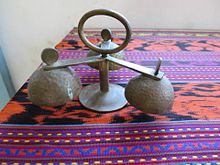
The first landing of the Portuguese on Timor is considered to be the beginning of the island's evangelization . On August 18, 1515, Portuguese Dominicans set foot on Timorese soil for the first time in what is now Oe-Cusse Ambeno . There they founded Lifau in 1556 as the first European settlement on Timor. The Dominicans worked closely with the Topasse , a mixed European-Asian population who advanced to become the real rulers in west Timor. Missionary work and economic interests went hand in hand. The first church on the island was built in Mena in 1590. In 1641 the Queen of Mena and her brother-in-law, the Liurai of Amanuban (Amanubang) , rulers of the area around Lifau, converted to Christianity, had several churches built and concluded an alliance with the Portuguese. After the campaign of Francisco Fernandes , several rulers of West Timor converted to Christianity and swore an oath of loyalty to the Portuguese crown, such as the ruler of Kupang. Timor was then given the name Ilha de Santa Cruz (Island of the Holy Cross), which the island kept for a long time. By 1640 a handful of priests had already founded ten missions and 22 churches in Timor.
In 1698 the Dominican Manuel de Santo António came to Timor. Through his successful missionary attempts around 1700, Luca and his neighboring empires in the southeast of the island also came under Portuguese influence. 1701 he was by Pope Clement XI. appointed Bishop of Malacca and resided in Lifau until 1722. Manuel de Santo António is therefore considered to be the first bishop in Timor. After two governors had previously failed in an attempt to regain control, Portugal sent in 1701 with António Coelho Guerreiro (1702-1705) again a governor to Timor , who began his service in Lifau on February 20, 1702. The Dominicans were officially released from the administration of the property, but Bishop Manuel de Santo António later took over the administration of the colony again when the post of governor was vacant. Other Dominicans did this again and again in the 18th century. In 1722 the new Portuguese governor António de Albuquerque Coelho arrived in Lifau. This banished Bishop Manuel de Santo António of Timor. Even later, the bishops of Malacca repeatedly resided in Lifau. In 1739, Bishop António de Castro came to Timor and founded the first seminary here in 1742. In 1743 he died at the age of 36 due to the climate. His remains were interred in Lifau. In 1749 Bishop Geraldo de São José came to Lifau. He is said to have died under mysterious circumstances in 1760.
Governor Feliciano António Nogueira Lisboa (1788–1790) got into an argument with the monk Francisco Luis da Cunha, the representative of the Catholic Church in Manatuto . Both accused each other of robbery and the theft of customs revenue, among other things. To get rid of the governor, the monk incited the people of Manatuto to rebellion. Christianized Timorese threatened to spread the revolt to the whole east of the island. Finally, the Viceroy of Goa took action , had both men arrested and deported from Timor. The new governor Joaquim Xavier de Morais Sarmento (1790–1794) brought the situation back under control.
Since the relocation of the colonial capital from Lifau to Dili in 1769, efforts in proselytizing Timor have decreased. The missionaries withdrew with their work to the more comfortable Dili or entirely from Timor. Since 1769 there have never been more than eleven missionaries on the island and in 1812 there were only two, including the bishop in Manatuto. In 1831 only five or six priests were still serving on the island. In 1834 the last missionaries were also banished from Timor for 20 years. The decree of King Peter IV was a consequence of the liberal revolution in Portugal . On December 26, 1854, the measure was withdrawn by royal decree and priests were sent from Goa to Timor and Mozambique . But even after the clergy had returned to Timor, missionary work in the interior of the island seemed to have been given up. In 1861 there were only two missionaries in the colony and they rarely left Dili. In 1874 attempts were made to promote the proselytizing of Timor again. On November 12, 1877, missionary work in the interior of the island was ordered by decree and the church was also given the right to found schools in the colony. In the same year nine new missionaries arrived in Timor and were distributed to Batugade , Oe-Cusse, Manatuto and Lacluta . Another four missionaries were sent to Bidau and Hera , and one took over the management of the elementary school in Motael . A missionary of Chinese descent was entrusted with the care of Chinese school children in Dili. Jacob dos Reis e Cunha, the son of a Liurai, had been ordained a priest in Macau and was missionary on the south coast between Luca and Alas . Before that he had been teaching the sons of Liurais in the mission school in Lahane since 1864 . Father António Joaquim de Medeiros was stationed in Dili as Vicar General and Superior of the Church . Medeiros estimated the number of Christians on the island at that time at just 40,000. Later responsibility for the colony was divided between two vicars general. The vicar general for the north coast resided in Dili, the one for the south coast from 1900 in the Missão do Sagrado Coração de Jesus in Soibada , which has now been expanded. A house for the missionaries, the Sacred Heart Church and two Colégios were built . The Colégio Nuno Álvares Pereira for the boys opened in 1904. The Colégio da Imaculada Conceição for girls started operating around 1910. Soibada was the religious and educational center in Timor at that time.

In 1910 the missionaries were expelled from the colony by the new republican government, which meant another setback in proselytizing. In 1916 there were only a dozen clergy in Portuguese Timor . From 1920 the church increased its commitment again. In 1928 the number of converted Timorese was just 19,000. With the new Portuguese constitution of 1933 and the laws of 1935, the 1910 decree was repealed and 20 missions were again operated in 1938. In 1937, José da Costa Nunes , Bishop of Macau , who was then subordinate to Portuguese Timor, visited the colony in Southeast Asia. In the Estado Novo , missionaries began to erect crosses and figures of saints at holy sites of the local religion. From 1940, the Catholic Church had a monopoly on education in the colony by means of a concordat . The church was associated with the local Portuguese administration and financed the education system from 1941. It conveyed both Catholic and Portuguese cultural values.
Together with Macau, Portuguese Timor formed a common diocese until the Diocese of Dili was separated on September 4, 1940. Jaime Garcia Goulart was appointed Apostolic Administrator on January 18, 1941 and nominated as the first Bishop of Dili on October 12, 1945. His consecration took place on October 28, 1945 in Sydney , where he had fled during the Japanese occupation of Portuguese Timor . On December 9, 1945, Goulart ceremoniously entered Dili. The pastoral structures, such as the old cathedral from 1909 and many other churches, had been destroyed in the war.
On January 31, 1967, José Joaquim Ribeiro , Goulart's assistant, was nominated as the new Bishop of Portuguese Timor when Goulart resigned. As a result of events during the Indonesian invasion of East Timor in 1975 , Ribeiro asked Pope Paul VI. about his retirement. This was granted on October 22, 1977. At the time, only about 30 percent of East Timor's population was Catholic. Ribeiro's successor was Vicar General Martinho da Costa Lopes .

Lopes was subordinated directly to the Pope. Under him and his successors, the Catholic Church became a refuge for the East Timorese. On April 7, at the suggestion of Lopes, the Vatican decreed that Tetum , the region's lingua franca , became the official language of the Catholic liturgy in East Timor after the occupation forces banned the use of Portuguese . Lopes repeatedly criticized the Indonesian war crimes, whereupon he was forced by the military to leave Dili in October 1981. On November 19, 1981, at a meeting of Catholic bishops with the Indonesian ruler Suharto, he again denounced the atrocities of the Indonesian armed forces. In another letter to Australia , Lopes again accused the Indonesian military of the crimes. Former Australian Prime Minister Gough Whitlam called the bishop a liar trying to stir up trouble. Whitlam's allegations were controversial and disseminated through agencies so that Indonesia could no longer tolerate Lopes' actions. The papal pro-nuncio in Jakarta is said to have been moved by an Indonesian general to recommend that the Pope recall Lopes as apostolic administrator. Lopes was retired on May 12, 1983 and died in Lisbon in 1991 .
Carlos Filipe Ximenes Belo , Apostolic Administrator from 1983 and 1988 ordained bishop, tried with the influence of the church to alleviate the suffering of the population. The visit of Pope John Paul II. October 12, 1989 in East Timor strengthened the confidence of the population and pushed the conflict for a short time back into the consciousness of the world public. After the mass, a group of young people unfolded banners. They demonstrated for self-determination and against human rights violations. This embarrassing moment for Indonesia was followed by a wave of arrests and torture. Belo's commitment and commitment to a referendum that would decide the future of East Timor earned him the Nobel Peace Prize in 1996 together with José Ramos-Horta . On November 30, 1996, Baucau was separated from Dili as a separate diocese. The apostolic administrator was Basílio do Nascimento .

In 2002 East Timor regained its independence. A statue of the Virgin Mary was shipped from Fátima (Portugal) to Dili for the celebrations and the land was consecrated to the Mother of God of Fátima. Belo resigned for health reasons on November 26, 2002. Basílio do Nascimento was now also Apostolic Administrator for the Diocese of Dili. In 2004 Alberto Ricardo da Silva took over the bishopric in Dili, while Nascimento, now consecrated as a bishop, remained responsible for the diocese of Baucau. In May 2005, after weeks of protest marches, religious education in public schools was reinstated as a compulsory subject in the curriculum. Prime Minister Alkatiri introduced a bill in February that the subject should only be attended voluntarily. On January 30, 2010, the diocese of Maliana was separated from Dili. Norberto do Amaral became bishop . When Silva resigned in 2015 and died shortly afterwards, Bishop Nascimento took over the administration of Dili again until the new Bishop Virgílio do Carmo da Silva followed in January 2016.
In 2019, allegations of abuse against a Catholic clergyman in East Timor became known for the first time .
Pope Francis elevated the diocese of Dili to the rank of archbishopric on September 11, 2019 and subordinated the dioceses of Baucau and Maliana as suffragan dioceses to him .
Christian sites
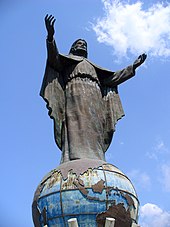
The Cathedral of Dili is the largest church in Southeast Asia. Its predecessor, the Church of Santo António de Motael , is often referred to as the oldest church in East Timor, although it was not built until 1955. The same is said of the Sacred Heart Church in Soibada , where the Jesuits founded the first mission school around 1900 , which still exists today. The cathedral of Baucau is modern , the new cathedral of Maliana is currently being built. The churches of Suai , Ossu and Viqueque have been major new buildings since 2002 , while in Lalaia the building dates from 1933. The Holy Cross Church serves as the cathedral of Maliana until the new building of the Sacred Heart Cathedral is completed.
In Tasitolu (Dili) a monumental statue and a church center commemorate the visit of John Paul II. They form a counterpoint to Cristo Rei , the monumental Jesus statue at the other end of Dili, which was bequeathed to the East Timorese by Indonesian President Suharto.
In Aitara there is a shrine of Mary, which is dedicated to the Holy Mother of Aitara (Nossa Senhora de Aitara). She is said to have appeared here on October 16 to several women, which is why the mission was established in nearby Soibada around 1900. Today Aitara is a national pilgrimage site.
Mariengrottos ( Grutas in Portuguese ) are widespread . You can find them sometimes by the wayside, sometimes at churches and are decorated with various depictions of Mary, but also Jesus and other saints. The Monument to the Mother of God ( Monumentu Nosa Señora, Monumento a Nossa Senhora , also Monumento da Imaculada Conceição ), in front of the Diocese of Dilis in Lecidere , was built under Governor César Maria de Serpa Rosa from 1954 and inaugurated in 1956. A three meter high statue of the Virgin Mary has been on the Tatamailau since 1997. The summit of Matebian has been crowned with a statue of Jesus since 1933, which is visited by thousands of pilgrims every October.
Great Christian festivities
- Carnival in Dili
- Good Friday procession (Procissão do Ama Senhor Morto) in Lifau , depicting the crucifixion of Jesus
- Saint Anthony feast in Manatuto on June 13th with equestrian games
literature
- Durand, Frédéric: Catholicisme et Protestantisme dans l'Ile de Timor 1556–2003: Construction d'une Identité Chrétienne et Engagement Politique Contemporain , Editions Arkuiris; Bangkok: IRASEC Toulouse 2004.
Web links
- Martinho G. da Silva Gusmão: Separation and Cooperation: Toward “Fairness” model of Inclusion of the Other Religions, Catholic Church and the State in Timor-Leste
supporting documents
Main evidence
- Frédéric Durand: Three centuries of violence and struggle in East Timor (1726-2008). (PDF; 243 kB) Online Encyclopedia of Mass Violence, (online), June 7, 2011, accessed on May 28, 2012, ISSN 1961-9898
- Geoffrey C. Gunn: History of Timor. Technical University of Lisbon (PDF file; 805 kB)
Individual evidence
- ↑ a b Direcção Nacional de Estatística: Population and Housing Census 2010, Population Distribution by Administrative Areas, Volume 2. ( Memento of the original from January 5, 2017 in the Internet Archive ) Info: The archive link was inserted automatically and has not yet been checked. Please check the original and archive link according to the instructions and then remove this notice. , accessed October 14, 2015.
- ^ Constitution of East Timor (Portuguese), accessed May 29, 2015.
- ↑ UCA news: Vatican, Timor-Leste sign bilateral agreement , August 14, 2015 , accessed on August 15, 2015.
- ↑ a b Damien Kingsbury: National Identity in Timor-Leste: A Brief Comparative Study , pp. 139-145, Swinburne Press 2009, accessed October 14, 2015.
- ↑ a b Australian Department of Defense, Patricia Dexter: Historical Analysis of Population Reactions to Stimuli - A case of East Timor ( Memento of September 13, 2007 in the Internet Archive ) (PDF; 1.1 MB)
- ↑ Scamberi, James: A Survey of Gangs and Youth Groups in Dili, Timor-Leste (PDF; 3.1 MB), accessed on May 20, 2012.
- ↑ a b Judith Bovensiepen, Frederico Delgado Rosa: Transformations of the sacred in East Timor , pp. 35-36, accessed on December 27, 2017.
- ^ Image of the monument to the first Portuguese landing on Timor
- ^ Geoffrey C. Gunn: History of Timor , pp. 29-32.
- ↑ a b Chronologie de l'histoire du Timor (1512–1945) suivie des événements récents (1975–1999) (French; PDF; 887 kB)
- ^ Geoffrey C. Gunn: History of Timor , p. 29.
- ↑ Religion Catholicism and ancestral cults - Center for Southeast Asian Studies, Northern Illinois University
- ^ Artur Teodoro de Matos: D. Frei Manuel de Santo António: missionário e primeiro bispo residente em Timor. Elementos para a sua biografia (1660–1733) ( Memento of the original from May 25, 2013 in the Internet Archive ) Info: The archive link was inserted automatically and has not yet been checked. Please check the original and archive link according to the instructions and then remove this notice. (Portuguese).
- ↑ a b Hans Hägerdal: Rebellions or factionalism? Timorese forms of resistance in an early colonial context, 1650–1769 ( Memento of the original from December 8, 2015 in the Internet Archive ) Info: The archive link was inserted automatically and has not yet been checked. Please check the original and archive link according to the instructions and then remove this notice.
- ↑ Instituto Camões ( Memento of the original dated August 5, 2011 in the Internet Archive ) Info: The archive link was inserted automatically and has not yet been checked. Please check the original and archive link according to the instructions and then remove this notice.
- ↑ Profiles Of Eminent Goans: Past And Present , Concept Publishing Company, New Delhi, ISBN 81-7022-619-8 .
- ^ Geoffrey C. Gunn: History of Timor , pp. 29-32.
- ↑ James J. Fox, “The Paradox of Powerlessness: Timor in Historical Perspective,” December 9, 1996, Department of Anthropology, Research School of Pacific and Asian Studies, The Australian National University ( Memento July 6, 2007 in the Internet Archive ) (PDF; 70 kB)
- ↑ Alberto Ricardo da Silva : HISTÓRIA BADAK DIOCESE DILI NIAN , April 24, 2015 , accessed on November 23, 2017.
- ↑ Forum Hakesuk: 1769 O Onzo de Agosto na História de Timor-Leste , accessed on 23 November 2017th
- ↑ Susana Barnes, Hans Hägerdal, Lisa Palmer: An East Timorese Domain - Luca from Central and Peripheral Perspectives , p. 332, 2017, DOI: 10.1163 / 22134379-17302020 .
- ↑ Forum Hakesuk: Confêrencia nas Celebrações do Primeiro Centenário do Nascimento do Senhor Dom Jaime Garcia Goulart , May 28, 2008 , accessed on November 23, 2017.
- ^ Geoffrey C. Gunn: History of Timor , p. 50.
- ^ Geoffrey C. Gunn: History of Timor , p. 65.
- ↑ Património de Influência Portuguesa: Mission of the Sacred Heart of Jesus , accessed November 15, 2016.
- ^ Durand, p. 5.
- ↑ Monika Schlicher: Intervention in Asia: The example of East Timor - conflict resolution without adequate prevention , March 2004, In: Prof. Thomas Hoppe (Ed.): Protection of human rights, civil interference and military intervention - analyzes and recommendations , project group Just Peace of the Germans Commission Justitia et Pax, 2004 / Verlag Dr. Köster, Berlin, Chapter 6, pp. 257-300.
- ^ Geoffrey C. Gunn: History of Timor , p. 165.
- ↑ Zenit, May 12, 2005, East Timor: Church and State solve the problem of religious education ( memento of the original from April 16, 2013 in the web archive archive.today ) Info: The archive link was automatically inserted and not yet checked. Please check the original and archive link according to the instructions and then remove this notice. , accessed May 20, 2012.
- ↑ Erezione della Diocesi di Maliana (Timor Orientale) e Nomina del primo Vescovo , in: Press Office of the Holy See: Daily Bulletin of January 30, 2010.
- ^ Pope Benedict XVI .: Apostolic Constitution Malianensis , January 30, 2010
- ↑ UCAnews: Laicized priest in Timor-Leste refuses to give up ministry , February 6, 2019 , accessed on February 8, 2019.
- ↑ erezione della Provincia Ecclesiastica di Dili (Timor Oriental) e nomina del primo Arcivescovo Metropolita. In: Daily Bulletin. Holy See Press Office , September 11, 2019, accessed September 11, 2019 (Italian).
- ↑ IMMACULATE CONCEPTION CATHEDRAL. (No longer available online.) Formerly in the original ; accessed on October 15, 2015 . ( Page no longer available , search in web archives ) Info: The link was automatically marked as defective. Please check the link according to the instructions and then remove this notice.
- ↑ Pittwater Friends of Soibada: Soibada ( February 16, 2014 memento in the Internet Archive ), accessed September 27, 2013
- ↑ Pictures of the Passion Play on the ZEESM Facebook account , accessed on June 11, 2014.
- ↑ Festival St. Antonio (Manatuto)



